Organisational Behaviour Report: Tesco Plc Case Study Analysis
VerifiedAdded on 2023/01/13
|14
|3911
|95
Report
AI Summary
This report provides an in-depth analysis of organisational behaviour within Tesco Plc, focusing on the impact of culture, politics, and power on individuals and teams. It examines various organisational cultures, including power, role, task, and person cultures, and discusses the importance of cultural-difference awareness, particularly in a global company like Tesco. The report also explores the application of Hofstede's dimensions of culture and the influence of globalisation and digital technology. Furthermore, it delves into motivational theories, such as Maslow's hierarchy of needs, Herzberg's motivation theory, expectancy theory, equity theory, and Locke's goal-setting theory, evaluating their implications for management and leadership. The report also addresses the significance of behavioural psychology and emotional intelligence in the workplace, concluding with an overview of team dynamics and cooperation within an organisation. The report aims to provide insights into improving employee performance and productivity through effective organisational behaviour strategies.
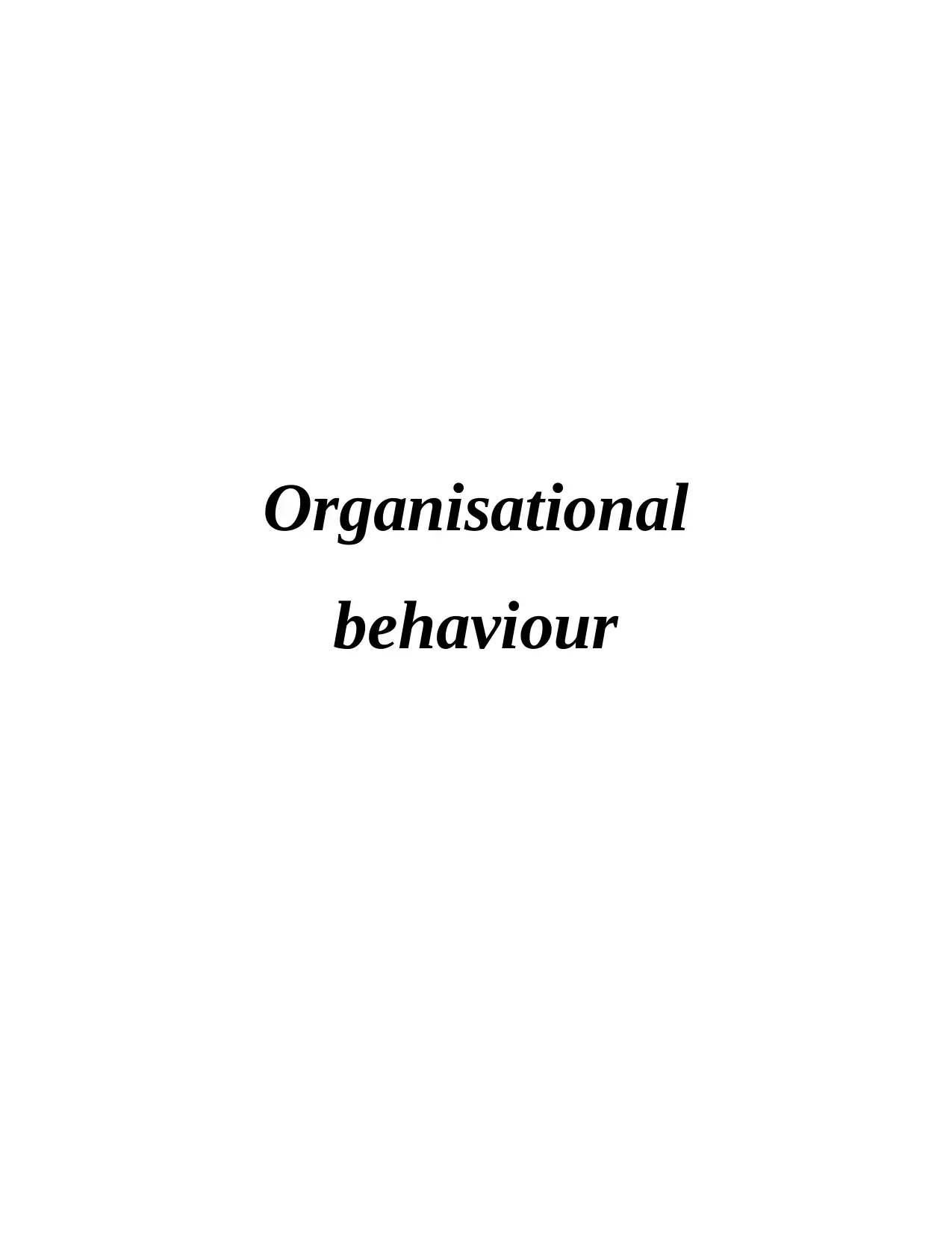
Organisational
behaviour
behaviour
Paraphrase This Document
Need a fresh take? Get an instant paraphrase of this document with our AI Paraphraser
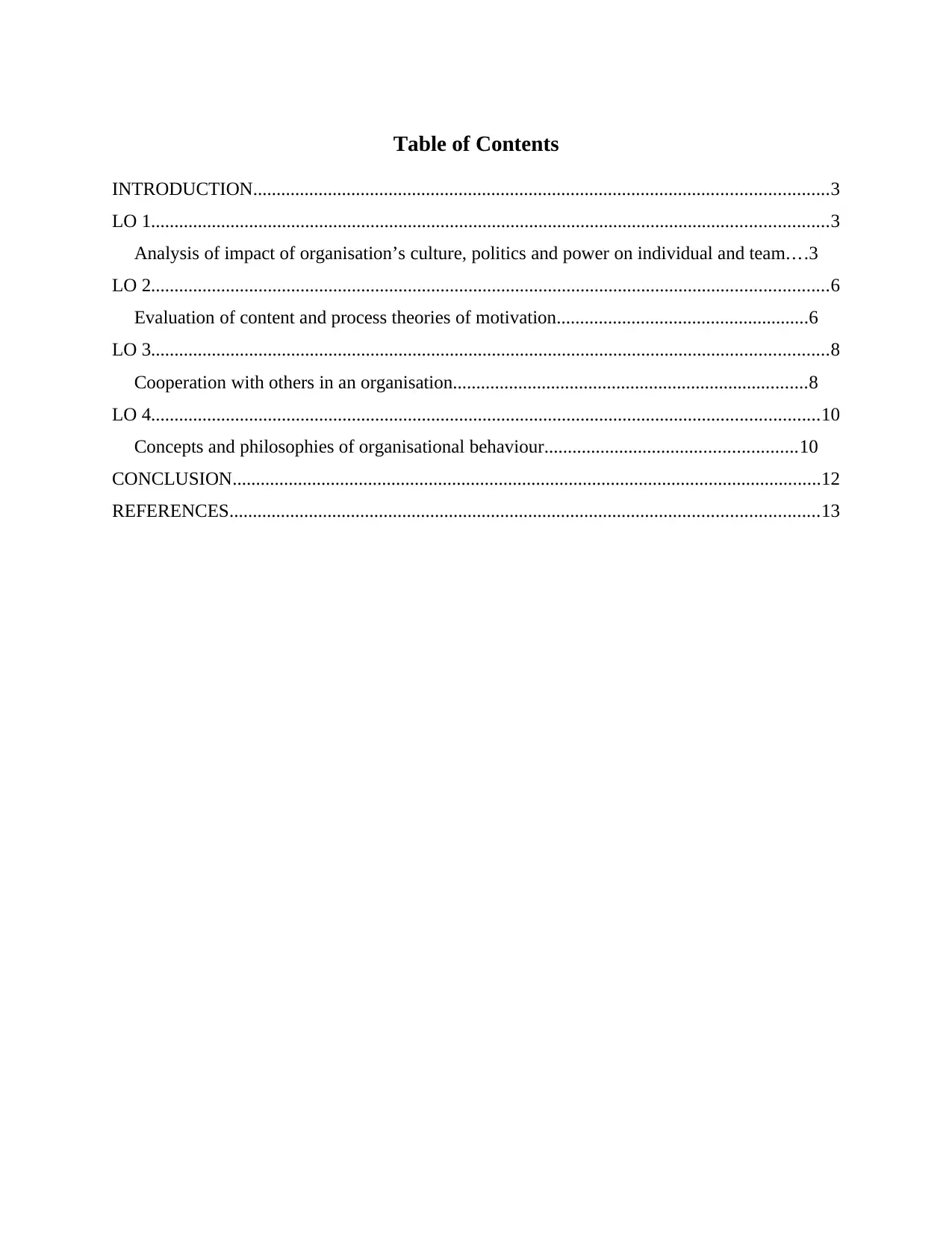
Table of Contents
INTRODUCTION...........................................................................................................................3
LO 1.................................................................................................................................................3
Analysis of impact of organisation’s culture, politics and power on individual and team....3
LO 2.................................................................................................................................................6
Evaluation of content and process theories of motivation......................................................6
LO 3.................................................................................................................................................8
Cooperation with others in an organisation............................................................................8
LO 4...............................................................................................................................................10
Concepts and philosophies of organisational behaviour......................................................10
CONCLUSION..............................................................................................................................12
REFERENCES..............................................................................................................................13
INTRODUCTION...........................................................................................................................3
LO 1.................................................................................................................................................3
Analysis of impact of organisation’s culture, politics and power on individual and team....3
LO 2.................................................................................................................................................6
Evaluation of content and process theories of motivation......................................................6
LO 3.................................................................................................................................................8
Cooperation with others in an organisation............................................................................8
LO 4...............................................................................................................................................10
Concepts and philosophies of organisational behaviour......................................................10
CONCLUSION..............................................................................................................................12
REFERENCES..............................................................................................................................13
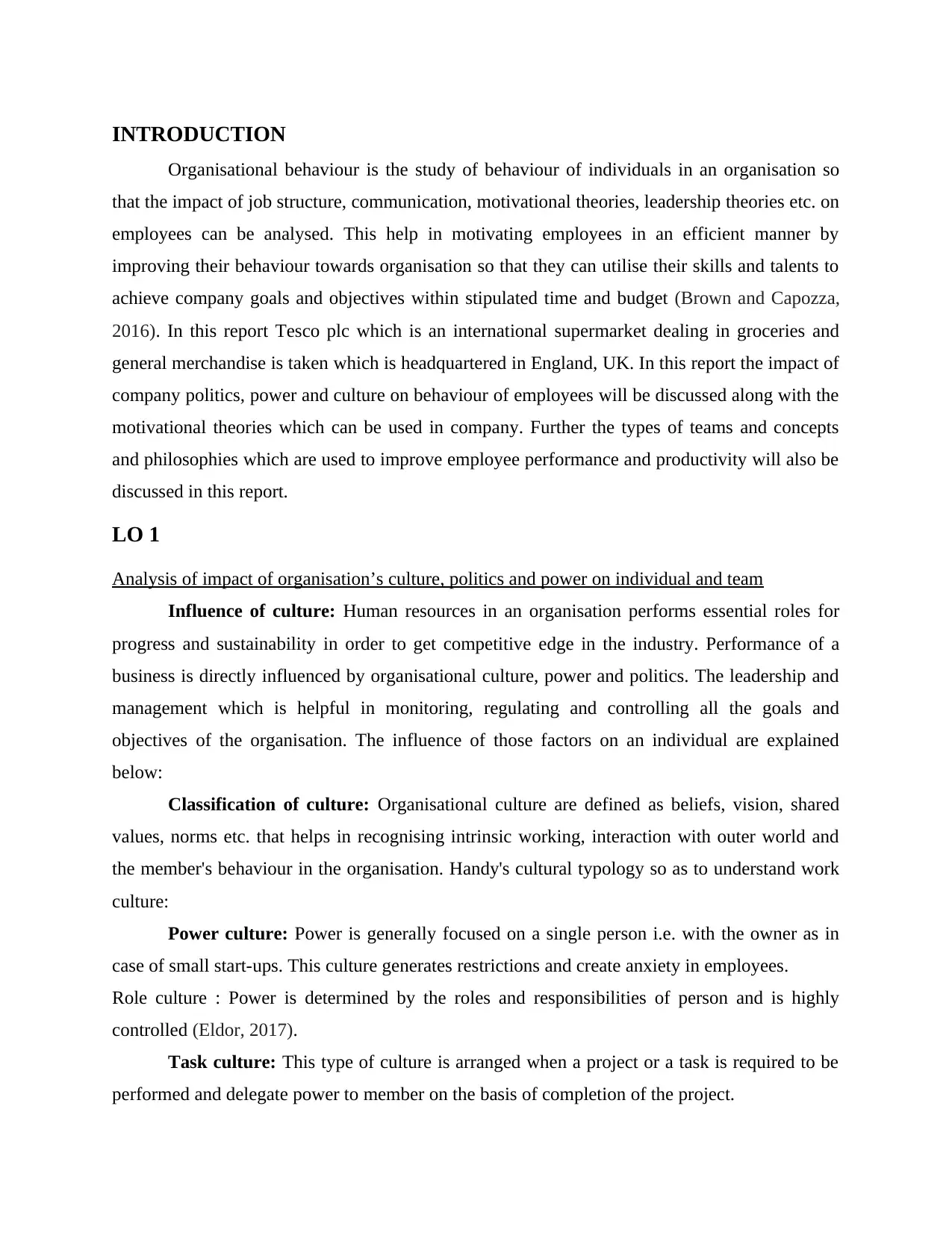
INTRODUCTION
Organisational behaviour is the study of behaviour of individuals in an organisation so
that the impact of job structure, communication, motivational theories, leadership theories etc. on
employees can be analysed. This help in motivating employees in an efficient manner by
improving their behaviour towards organisation so that they can utilise their skills and talents to
achieve company goals and objectives within stipulated time and budget (Brown and Capozza,
2016). In this report Tesco plc which is an international supermarket dealing in groceries and
general merchandise is taken which is headquartered in England, UK. In this report the impact of
company politics, power and culture on behaviour of employees will be discussed along with the
motivational theories which can be used in company. Further the types of teams and concepts
and philosophies which are used to improve employee performance and productivity will also be
discussed in this report.
LO 1
Analysis of impact of organisation’s culture, politics and power on individual and team
Influence of culture: Human resources in an organisation performs essential roles for
progress and sustainability in order to get competitive edge in the industry. Performance of a
business is directly influenced by organisational culture, power and politics. The leadership and
management which is helpful in monitoring, regulating and controlling all the goals and
objectives of the organisation. The influence of those factors on an individual are explained
below:
Classification of culture: Organisational culture are defined as beliefs, vision, shared
values, norms etc. that helps in recognising intrinsic working, interaction with outer world and
the member's behaviour in the organisation. Handy's cultural typology so as to understand work
culture:
Power culture: Power is generally focused on a single person i.e. with the owner as in
case of small start-ups. This culture generates restrictions and create anxiety in employees.
Role culture : Power is determined by the roles and responsibilities of person and is highly
controlled (Eldor, 2017).
Task culture: This type of culture is arranged when a project or a task is required to be
performed and delegate power to member on the basis of completion of the project.
Organisational behaviour is the study of behaviour of individuals in an organisation so
that the impact of job structure, communication, motivational theories, leadership theories etc. on
employees can be analysed. This help in motivating employees in an efficient manner by
improving their behaviour towards organisation so that they can utilise their skills and talents to
achieve company goals and objectives within stipulated time and budget (Brown and Capozza,
2016). In this report Tesco plc which is an international supermarket dealing in groceries and
general merchandise is taken which is headquartered in England, UK. In this report the impact of
company politics, power and culture on behaviour of employees will be discussed along with the
motivational theories which can be used in company. Further the types of teams and concepts
and philosophies which are used to improve employee performance and productivity will also be
discussed in this report.
LO 1
Analysis of impact of organisation’s culture, politics and power on individual and team
Influence of culture: Human resources in an organisation performs essential roles for
progress and sustainability in order to get competitive edge in the industry. Performance of a
business is directly influenced by organisational culture, power and politics. The leadership and
management which is helpful in monitoring, regulating and controlling all the goals and
objectives of the organisation. The influence of those factors on an individual are explained
below:
Classification of culture: Organisational culture are defined as beliefs, vision, shared
values, norms etc. that helps in recognising intrinsic working, interaction with outer world and
the member's behaviour in the organisation. Handy's cultural typology so as to understand work
culture:
Power culture: Power is generally focused on a single person i.e. with the owner as in
case of small start-ups. This culture generates restrictions and create anxiety in employees.
Role culture : Power is determined by the roles and responsibilities of person and is highly
controlled (Eldor, 2017).
Task culture: This type of culture is arranged when a project or a task is required to be
performed and delegate power to member on the basis of completion of the project.
⊘ This is a preview!⊘
Do you want full access?
Subscribe today to unlock all pages.

Trusted by 1+ million students worldwide
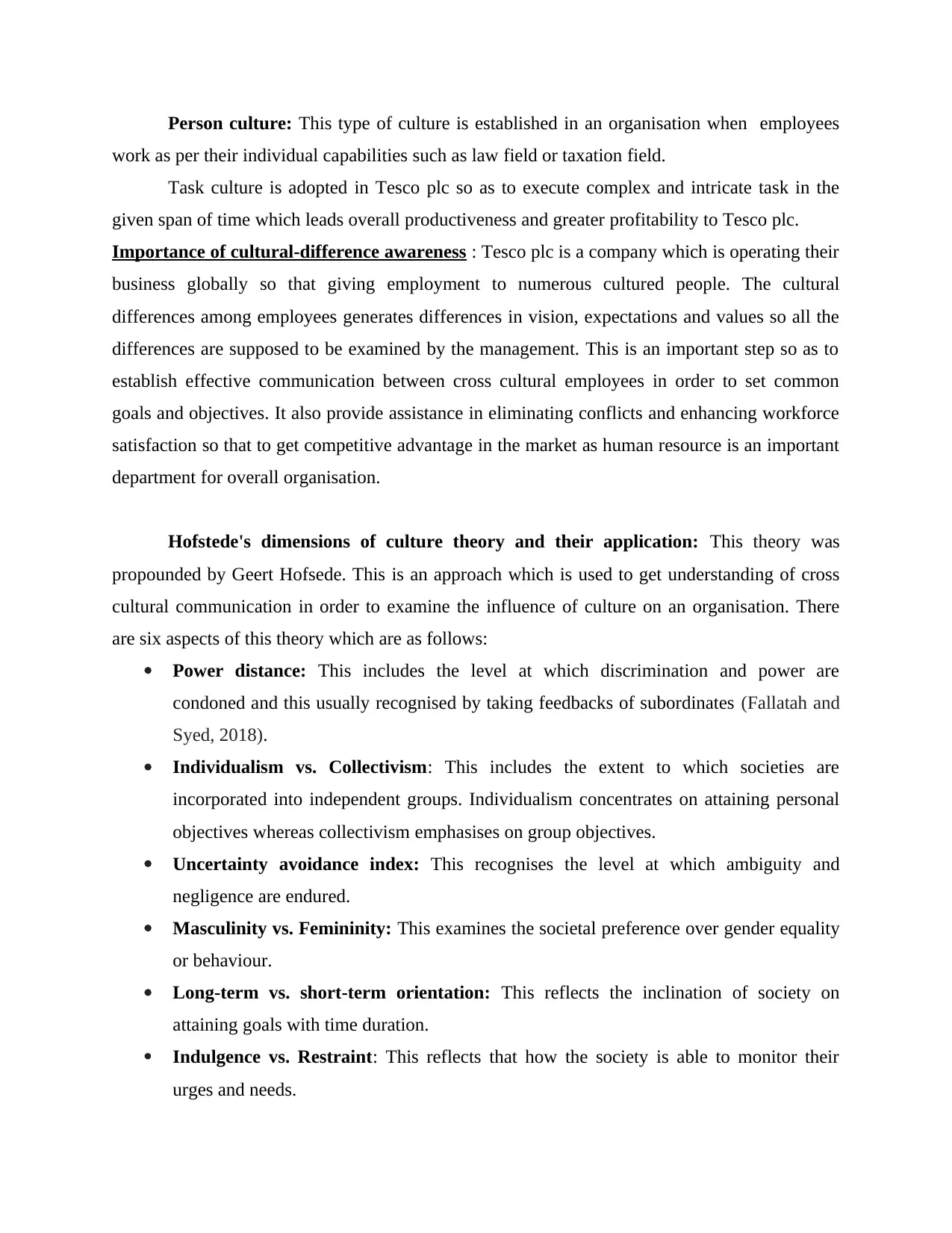
Person culture: This type of culture is established in an organisation when employees
work as per their individual capabilities such as law field or taxation field.
Task culture is adopted in Tesco plc so as to execute complex and intricate task in the
given span of time which leads overall productiveness and greater profitability to Tesco plc.
Importance of cultural-difference awareness : Tesco plc is a company which is operating their
business globally so that giving employment to numerous cultured people. The cultural
differences among employees generates differences in vision, expectations and values so all the
differences are supposed to be examined by the management. This is an important step so as to
establish effective communication between cross cultural employees in order to set common
goals and objectives. It also provide assistance in eliminating conflicts and enhancing workforce
satisfaction so that to get competitive advantage in the market as human resource is an important
department for overall organisation.
Hofstede's dimensions of culture theory and their application: This theory was
propounded by Geert Hofsede. This is an approach which is used to get understanding of cross
cultural communication in order to examine the influence of culture on an organisation. There
are six aspects of this theory which are as follows:
Power distance: This includes the level at which discrimination and power are
condoned and this usually recognised by taking feedbacks of subordinates (Fallatah and
Syed, 2018).
Individualism vs. Collectivism: This includes the extent to which societies are
incorporated into independent groups. Individualism concentrates on attaining personal
objectives whereas collectivism emphasises on group objectives.
Uncertainty avoidance index: This recognises the level at which ambiguity and
negligence are endured.
Masculinity vs. Femininity: This examines the societal preference over gender equality
or behaviour.
Long-term vs. short-term orientation: This reflects the inclination of society on
attaining goals with time duration.
Indulgence vs. Restraint: This reflects that how the society is able to monitor their
urges and needs.
work as per their individual capabilities such as law field or taxation field.
Task culture is adopted in Tesco plc so as to execute complex and intricate task in the
given span of time which leads overall productiveness and greater profitability to Tesco plc.
Importance of cultural-difference awareness : Tesco plc is a company which is operating their
business globally so that giving employment to numerous cultured people. The cultural
differences among employees generates differences in vision, expectations and values so all the
differences are supposed to be examined by the management. This is an important step so as to
establish effective communication between cross cultural employees in order to set common
goals and objectives. It also provide assistance in eliminating conflicts and enhancing workforce
satisfaction so that to get competitive advantage in the market as human resource is an important
department for overall organisation.
Hofstede's dimensions of culture theory and their application: This theory was
propounded by Geert Hofsede. This is an approach which is used to get understanding of cross
cultural communication in order to examine the influence of culture on an organisation. There
are six aspects of this theory which are as follows:
Power distance: This includes the level at which discrimination and power are
condoned and this usually recognised by taking feedbacks of subordinates (Fallatah and
Syed, 2018).
Individualism vs. Collectivism: This includes the extent to which societies are
incorporated into independent groups. Individualism concentrates on attaining personal
objectives whereas collectivism emphasises on group objectives.
Uncertainty avoidance index: This recognises the level at which ambiguity and
negligence are endured.
Masculinity vs. Femininity: This examines the societal preference over gender equality
or behaviour.
Long-term vs. short-term orientation: This reflects the inclination of society on
attaining goals with time duration.
Indulgence vs. Restraint: This reflects that how the society is able to monitor their
urges and needs.
Paraphrase This Document
Need a fresh take? Get an instant paraphrase of this document with our AI Paraphraser
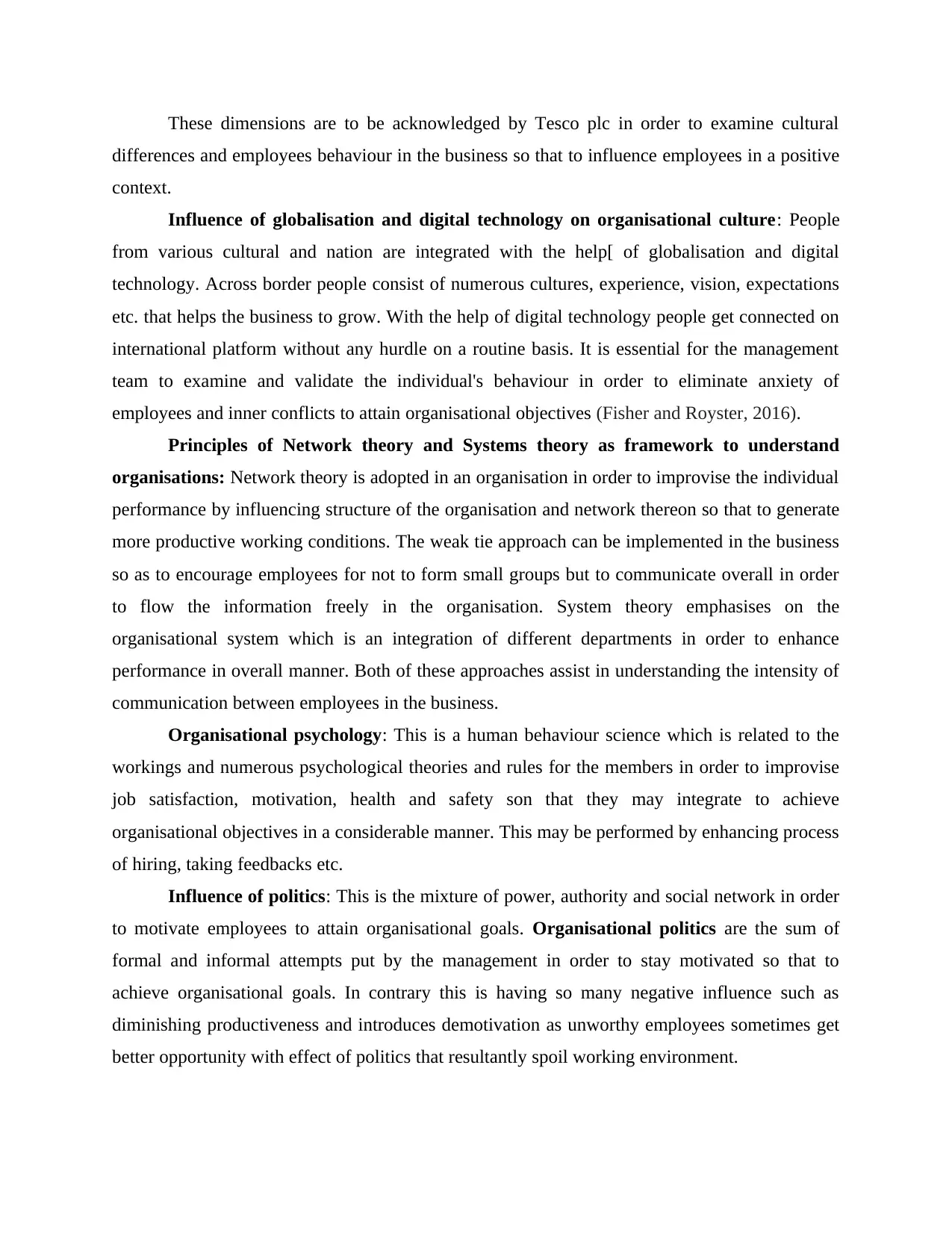
These dimensions are to be acknowledged by Tesco plc in order to examine cultural
differences and employees behaviour in the business so that to influence employees in a positive
context.
Influence of globalisation and digital technology on organisational culture: People
from various cultural and nation are integrated with the help[ of globalisation and digital
technology. Across border people consist of numerous cultures, experience, vision, expectations
etc. that helps the business to grow. With the help of digital technology people get connected on
international platform without any hurdle on a routine basis. It is essential for the management
team to examine and validate the individual's behaviour in order to eliminate anxiety of
employees and inner conflicts to attain organisational objectives (Fisher and Royster, 2016).
Principles of Network theory and Systems theory as framework to understand
organisations: Network theory is adopted in an organisation in order to improvise the individual
performance by influencing structure of the organisation and network thereon so that to generate
more productive working conditions. The weak tie approach can be implemented in the business
so as to encourage employees for not to form small groups but to communicate overall in order
to flow the information freely in the organisation. System theory emphasises on the
organisational system which is an integration of different departments in order to enhance
performance in overall manner. Both of these approaches assist in understanding the intensity of
communication between employees in the business.
Organisational psychology: This is a human behaviour science which is related to the
workings and numerous psychological theories and rules for the members in order to improvise
job satisfaction, motivation, health and safety son that they may integrate to achieve
organisational objectives in a considerable manner. This may be performed by enhancing process
of hiring, taking feedbacks etc.
Influence of politics: This is the mixture of power, authority and social network in order
to motivate employees to attain organisational goals. Organisational politics are the sum of
formal and informal attempts put by the management in order to stay motivated so that to
achieve organisational goals. In contrary this is having so many negative influence such as
diminishing productiveness and introduces demotivation as unworthy employees sometimes get
better opportunity with effect of politics that resultantly spoil working environment.
differences and employees behaviour in the business so that to influence employees in a positive
context.
Influence of globalisation and digital technology on organisational culture: People
from various cultural and nation are integrated with the help[ of globalisation and digital
technology. Across border people consist of numerous cultures, experience, vision, expectations
etc. that helps the business to grow. With the help of digital technology people get connected on
international platform without any hurdle on a routine basis. It is essential for the management
team to examine and validate the individual's behaviour in order to eliminate anxiety of
employees and inner conflicts to attain organisational objectives (Fisher and Royster, 2016).
Principles of Network theory and Systems theory as framework to understand
organisations: Network theory is adopted in an organisation in order to improvise the individual
performance by influencing structure of the organisation and network thereon so that to generate
more productive working conditions. The weak tie approach can be implemented in the business
so as to encourage employees for not to form small groups but to communicate overall in order
to flow the information freely in the organisation. System theory emphasises on the
organisational system which is an integration of different departments in order to enhance
performance in overall manner. Both of these approaches assist in understanding the intensity of
communication between employees in the business.
Organisational psychology: This is a human behaviour science which is related to the
workings and numerous psychological theories and rules for the members in order to improvise
job satisfaction, motivation, health and safety son that they may integrate to achieve
organisational objectives in a considerable manner. This may be performed by enhancing process
of hiring, taking feedbacks etc.
Influence of politics: This is the mixture of power, authority and social network in order
to motivate employees to attain organisational goals. Organisational politics are the sum of
formal and informal attempts put by the management in order to stay motivated so that to
achieve organisational goals. In contrary this is having so many negative influence such as
diminishing productiveness and introduces demotivation as unworthy employees sometimes get
better opportunity with effect of politics that resultantly spoil working environment.
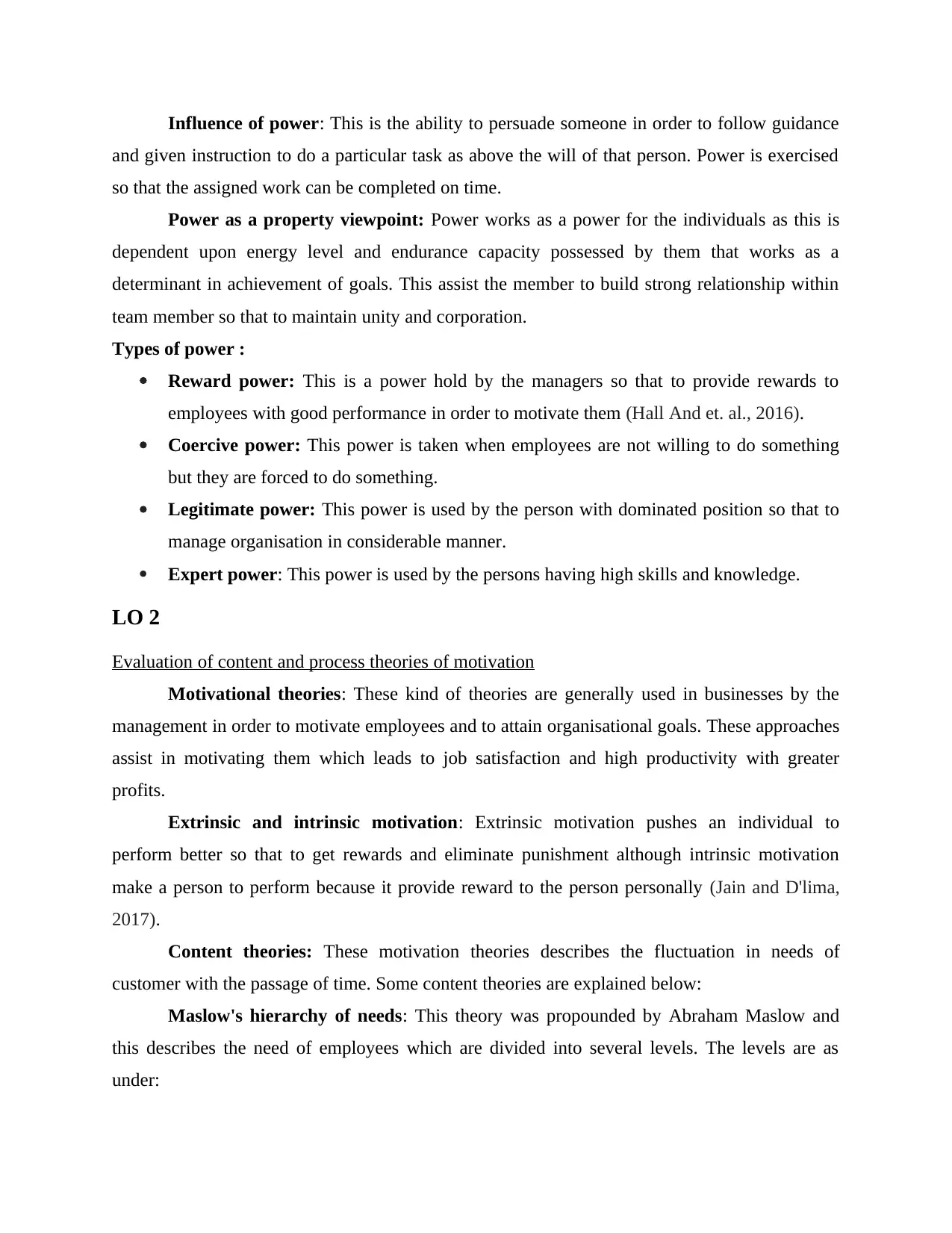
Influence of power: This is the ability to persuade someone in order to follow guidance
and given instruction to do a particular task as above the will of that person. Power is exercised
so that the assigned work can be completed on time.
Power as a property viewpoint: Power works as a power for the individuals as this is
dependent upon energy level and endurance capacity possessed by them that works as a
determinant in achievement of goals. This assist the member to build strong relationship within
team member so that to maintain unity and corporation.
Types of power :
Reward power: This is a power hold by the managers so that to provide rewards to
employees with good performance in order to motivate them (Hall And et. al., 2016).
Coercive power: This power is taken when employees are not willing to do something
but they are forced to do something.
Legitimate power: This power is used by the person with dominated position so that to
manage organisation in considerable manner.
Expert power: This power is used by the persons having high skills and knowledge.
LO 2
Evaluation of content and process theories of motivation
Motivational theories: These kind of theories are generally used in businesses by the
management in order to motivate employees and to attain organisational goals. These approaches
assist in motivating them which leads to job satisfaction and high productivity with greater
profits.
Extrinsic and intrinsic motivation: Extrinsic motivation pushes an individual to
perform better so that to get rewards and eliminate punishment although intrinsic motivation
make a person to perform because it provide reward to the person personally (Jain and D'lima,
2017).
Content theories: These motivation theories describes the fluctuation in needs of
customer with the passage of time. Some content theories are explained below:
Maslow's hierarchy of needs: This theory was propounded by Abraham Maslow and
this describes the need of employees which are divided into several levels. The levels are as
under:
and given instruction to do a particular task as above the will of that person. Power is exercised
so that the assigned work can be completed on time.
Power as a property viewpoint: Power works as a power for the individuals as this is
dependent upon energy level and endurance capacity possessed by them that works as a
determinant in achievement of goals. This assist the member to build strong relationship within
team member so that to maintain unity and corporation.
Types of power :
Reward power: This is a power hold by the managers so that to provide rewards to
employees with good performance in order to motivate them (Hall And et. al., 2016).
Coercive power: This power is taken when employees are not willing to do something
but they are forced to do something.
Legitimate power: This power is used by the person with dominated position so that to
manage organisation in considerable manner.
Expert power: This power is used by the persons having high skills and knowledge.
LO 2
Evaluation of content and process theories of motivation
Motivational theories: These kind of theories are generally used in businesses by the
management in order to motivate employees and to attain organisational goals. These approaches
assist in motivating them which leads to job satisfaction and high productivity with greater
profits.
Extrinsic and intrinsic motivation: Extrinsic motivation pushes an individual to
perform better so that to get rewards and eliminate punishment although intrinsic motivation
make a person to perform because it provide reward to the person personally (Jain and D'lima,
2017).
Content theories: These motivation theories describes the fluctuation in needs of
customer with the passage of time. Some content theories are explained below:
Maslow's hierarchy of needs: This theory was propounded by Abraham Maslow and
this describes the need of employees which are divided into several levels. The levels are as
under:
⊘ This is a preview!⊘
Do you want full access?
Subscribe today to unlock all pages.

Trusted by 1+ million students worldwide
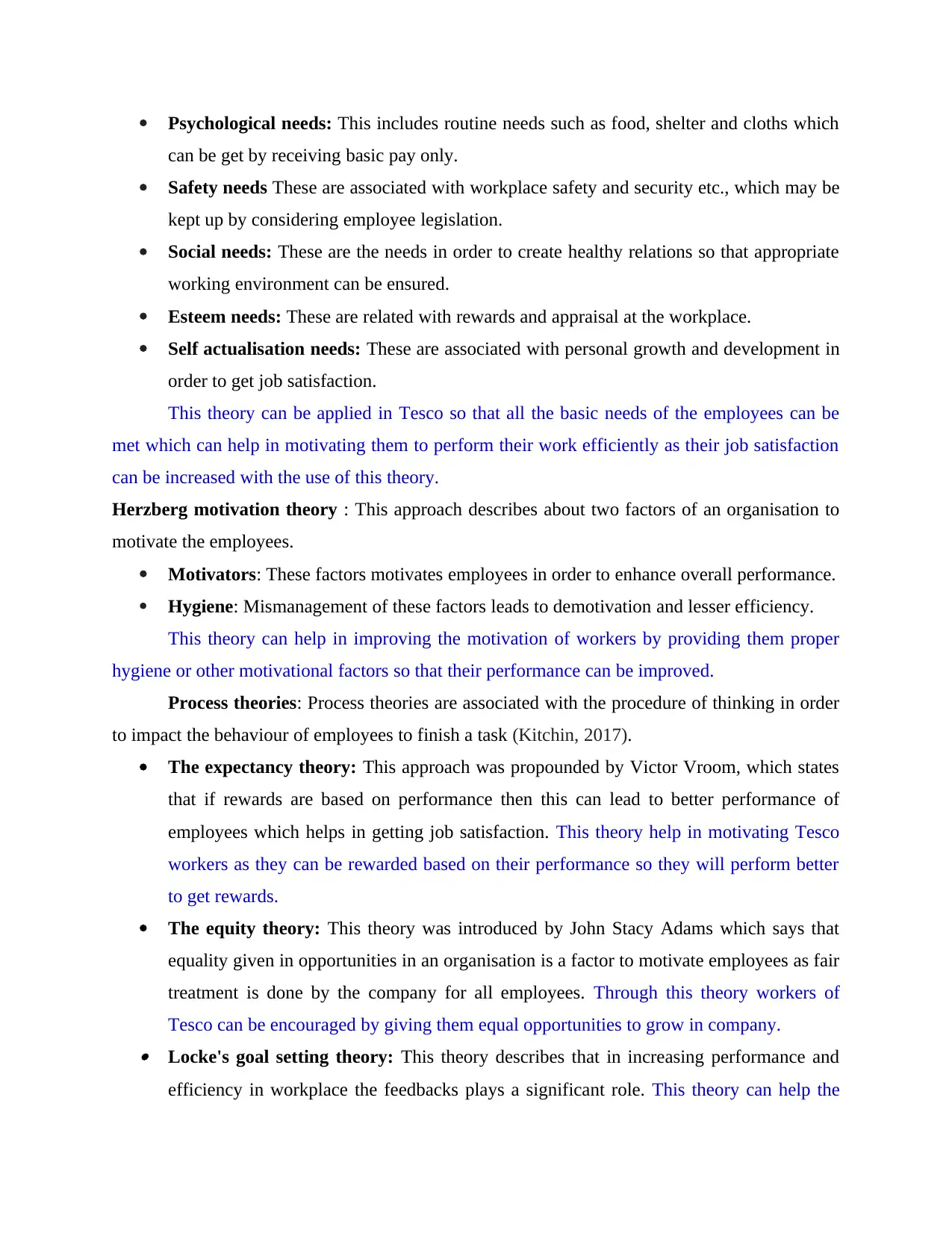
Psychological needs: This includes routine needs such as food, shelter and cloths which
can be get by receiving basic pay only.
Safety needs These are associated with workplace safety and security etc., which may be
kept up by considering employee legislation.
Social needs: These are the needs in order to create healthy relations so that appropriate
working environment can be ensured.
Esteem needs: These are related with rewards and appraisal at the workplace.
Self actualisation needs: These are associated with personal growth and development in
order to get job satisfaction.
This theory can be applied in Tesco so that all the basic needs of the employees can be
met which can help in motivating them to perform their work efficiently as their job satisfaction
can be increased with the use of this theory.
Herzberg motivation theory : This approach describes about two factors of an organisation to
motivate the employees.
Motivators: These factors motivates employees in order to enhance overall performance.
Hygiene: Mismanagement of these factors leads to demotivation and lesser efficiency.
This theory can help in improving the motivation of workers by providing them proper
hygiene or other motivational factors so that their performance can be improved.
Process theories: Process theories are associated with the procedure of thinking in order
to impact the behaviour of employees to finish a task (Kitchin, 2017).
The expectancy theory: This approach was propounded by Victor Vroom, which states
that if rewards are based on performance then this can lead to better performance of
employees which helps in getting job satisfaction. This theory help in motivating Tesco
workers as they can be rewarded based on their performance so they will perform better
to get rewards.
The equity theory: This theory was introduced by John Stacy Adams which says that
equality given in opportunities in an organisation is a factor to motivate employees as fair
treatment is done by the company for all employees. Through this theory workers of
Tesco can be encouraged by giving them equal opportunities to grow in company. Locke's goal setting theory: This theory describes that in increasing performance and
efficiency in workplace the feedbacks plays a significant role. This theory can help the
can be get by receiving basic pay only.
Safety needs These are associated with workplace safety and security etc., which may be
kept up by considering employee legislation.
Social needs: These are the needs in order to create healthy relations so that appropriate
working environment can be ensured.
Esteem needs: These are related with rewards and appraisal at the workplace.
Self actualisation needs: These are associated with personal growth and development in
order to get job satisfaction.
This theory can be applied in Tesco so that all the basic needs of the employees can be
met which can help in motivating them to perform their work efficiently as their job satisfaction
can be increased with the use of this theory.
Herzberg motivation theory : This approach describes about two factors of an organisation to
motivate the employees.
Motivators: These factors motivates employees in order to enhance overall performance.
Hygiene: Mismanagement of these factors leads to demotivation and lesser efficiency.
This theory can help in improving the motivation of workers by providing them proper
hygiene or other motivational factors so that their performance can be improved.
Process theories: Process theories are associated with the procedure of thinking in order
to impact the behaviour of employees to finish a task (Kitchin, 2017).
The expectancy theory: This approach was propounded by Victor Vroom, which states
that if rewards are based on performance then this can lead to better performance of
employees which helps in getting job satisfaction. This theory help in motivating Tesco
workers as they can be rewarded based on their performance so they will perform better
to get rewards.
The equity theory: This theory was introduced by John Stacy Adams which says that
equality given in opportunities in an organisation is a factor to motivate employees as fair
treatment is done by the company for all employees. Through this theory workers of
Tesco can be encouraged by giving them equal opportunities to grow in company. Locke's goal setting theory: This theory describes that in increasing performance and
efficiency in workplace the feedbacks plays a significant role. This theory can help the
Paraphrase This Document
Need a fresh take? Get an instant paraphrase of this document with our AI Paraphraser
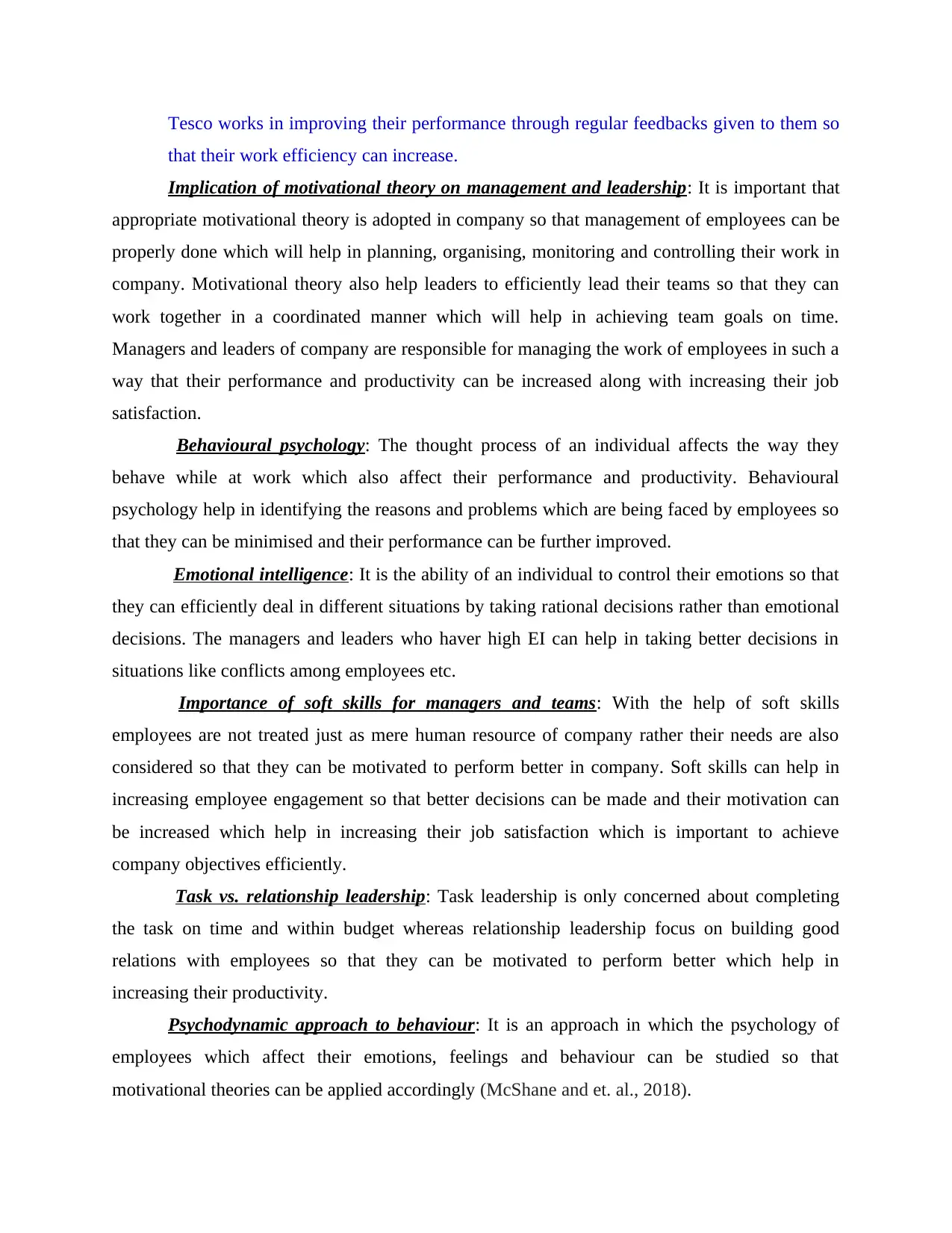
Tesco works in improving their performance through regular feedbacks given to them so
that their work efficiency can increase.
Implication of motivational theory on management and leadership: It is important that
appropriate motivational theory is adopted in company so that management of employees can be
properly done which will help in planning, organising, monitoring and controlling their work in
company. Motivational theory also help leaders to efficiently lead their teams so that they can
work together in a coordinated manner which will help in achieving team goals on time.
Managers and leaders of company are responsible for managing the work of employees in such a
way that their performance and productivity can be increased along with increasing their job
satisfaction.
Behavioural psychology: The thought process of an individual affects the way they
behave while at work which also affect their performance and productivity. Behavioural
psychology help in identifying the reasons and problems which are being faced by employees so
that they can be minimised and their performance can be further improved.
Emotional intelligence: It is the ability of an individual to control their emotions so that
they can efficiently deal in different situations by taking rational decisions rather than emotional
decisions. The managers and leaders who haver high EI can help in taking better decisions in
situations like conflicts among employees etc.
Importance of soft skills for managers and teams: With the help of soft skills
employees are not treated just as mere human resource of company rather their needs are also
considered so that they can be motivated to perform better in company. Soft skills can help in
increasing employee engagement so that better decisions can be made and their motivation can
be increased which help in increasing their job satisfaction which is important to achieve
company objectives efficiently.
Task vs. relationship leadership: Task leadership is only concerned about completing
the task on time and within budget whereas relationship leadership focus on building good
relations with employees so that they can be motivated to perform better which help in
increasing their productivity.
Psychodynamic approach to behaviour: It is an approach in which the psychology of
employees which affect their emotions, feelings and behaviour can be studied so that
motivational theories can be applied accordingly (McShane and et. al., 2018).
that their work efficiency can increase.
Implication of motivational theory on management and leadership: It is important that
appropriate motivational theory is adopted in company so that management of employees can be
properly done which will help in planning, organising, monitoring and controlling their work in
company. Motivational theory also help leaders to efficiently lead their teams so that they can
work together in a coordinated manner which will help in achieving team goals on time.
Managers and leaders of company are responsible for managing the work of employees in such a
way that their performance and productivity can be increased along with increasing their job
satisfaction.
Behavioural psychology: The thought process of an individual affects the way they
behave while at work which also affect their performance and productivity. Behavioural
psychology help in identifying the reasons and problems which are being faced by employees so
that they can be minimised and their performance can be further improved.
Emotional intelligence: It is the ability of an individual to control their emotions so that
they can efficiently deal in different situations by taking rational decisions rather than emotional
decisions. The managers and leaders who haver high EI can help in taking better decisions in
situations like conflicts among employees etc.
Importance of soft skills for managers and teams: With the help of soft skills
employees are not treated just as mere human resource of company rather their needs are also
considered so that they can be motivated to perform better in company. Soft skills can help in
increasing employee engagement so that better decisions can be made and their motivation can
be increased which help in increasing their job satisfaction which is important to achieve
company objectives efficiently.
Task vs. relationship leadership: Task leadership is only concerned about completing
the task on time and within budget whereas relationship leadership focus on building good
relations with employees so that they can be motivated to perform better which help in
increasing their productivity.
Psychodynamic approach to behaviour: It is an approach in which the psychology of
employees which affect their emotions, feelings and behaviour can be studied so that
motivational theories can be applied accordingly (McShane and et. al., 2018).
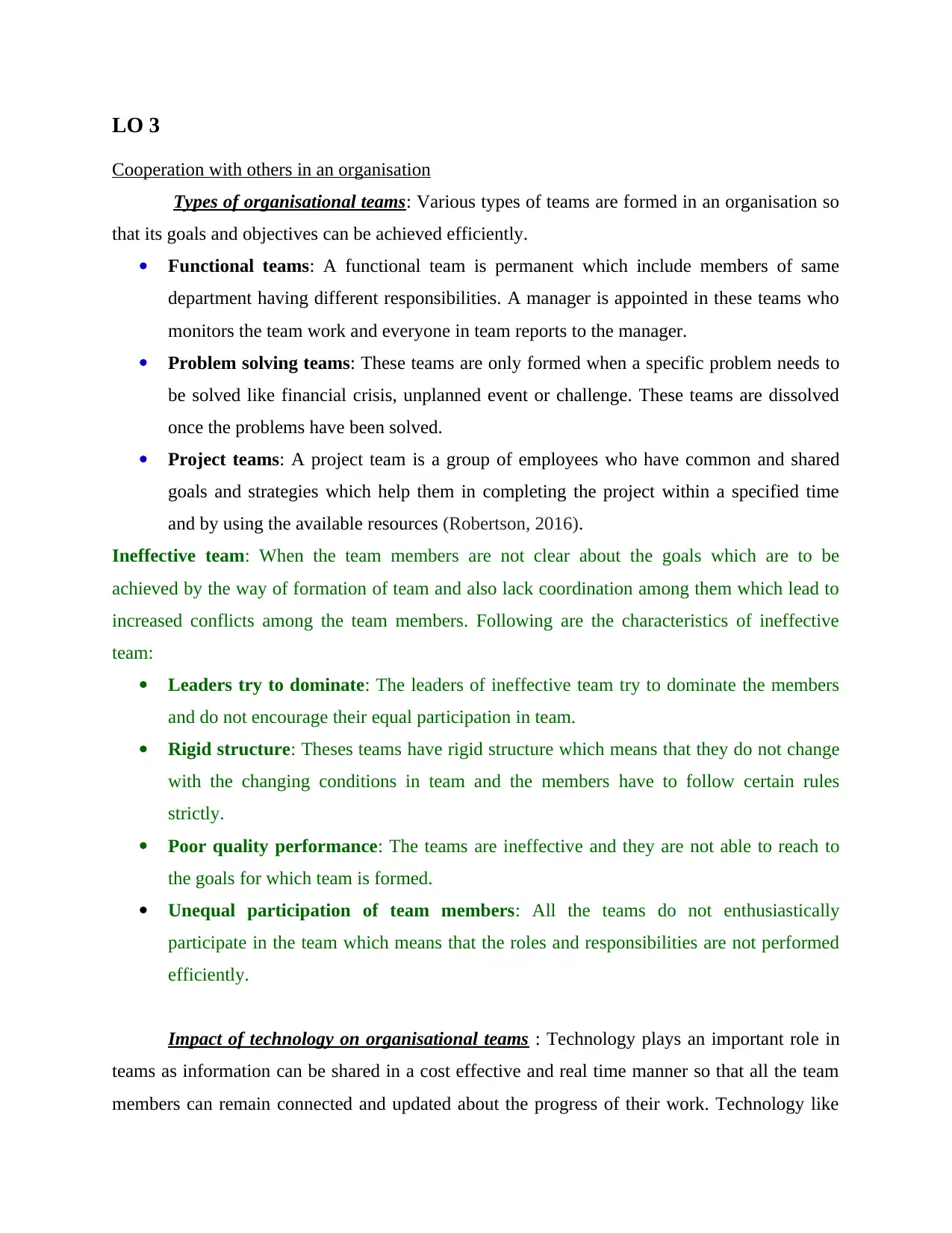
LO 3
Cooperation with others in an organisation
Types of organisational teams: Various types of teams are formed in an organisation so
that its goals and objectives can be achieved efficiently.
Functional teams: A functional team is permanent which include members of same
department having different responsibilities. A manager is appointed in these teams who
monitors the team work and everyone in team reports to the manager.
Problem solving teams: These teams are only formed when a specific problem needs to
be solved like financial crisis, unplanned event or challenge. These teams are dissolved
once the problems have been solved.
Project teams: A project team is a group of employees who have common and shared
goals and strategies which help them in completing the project within a specified time
and by using the available resources (Robertson, 2016).
Ineffective team: When the team members are not clear about the goals which are to be
achieved by the way of formation of team and also lack coordination among them which lead to
increased conflicts among the team members. Following are the characteristics of ineffective
team:
Leaders try to dominate: The leaders of ineffective team try to dominate the members
and do not encourage their equal participation in team.
Rigid structure: Theses teams have rigid structure which means that they do not change
with the changing conditions in team and the members have to follow certain rules
strictly.
Poor quality performance: The teams are ineffective and they are not able to reach to
the goals for which team is formed.
Unequal participation of team members: All the teams do not enthusiastically
participate in the team which means that the roles and responsibilities are not performed
efficiently.
Impact of technology on organisational teams : Technology plays an important role in
teams as information can be shared in a cost effective and real time manner so that all the team
members can remain connected and updated about the progress of their work. Technology like
Cooperation with others in an organisation
Types of organisational teams: Various types of teams are formed in an organisation so
that its goals and objectives can be achieved efficiently.
Functional teams: A functional team is permanent which include members of same
department having different responsibilities. A manager is appointed in these teams who
monitors the team work and everyone in team reports to the manager.
Problem solving teams: These teams are only formed when a specific problem needs to
be solved like financial crisis, unplanned event or challenge. These teams are dissolved
once the problems have been solved.
Project teams: A project team is a group of employees who have common and shared
goals and strategies which help them in completing the project within a specified time
and by using the available resources (Robertson, 2016).
Ineffective team: When the team members are not clear about the goals which are to be
achieved by the way of formation of team and also lack coordination among them which lead to
increased conflicts among the team members. Following are the characteristics of ineffective
team:
Leaders try to dominate: The leaders of ineffective team try to dominate the members
and do not encourage their equal participation in team.
Rigid structure: Theses teams have rigid structure which means that they do not change
with the changing conditions in team and the members have to follow certain rules
strictly.
Poor quality performance: The teams are ineffective and they are not able to reach to
the goals for which team is formed.
Unequal participation of team members: All the teams do not enthusiastically
participate in the team which means that the roles and responsibilities are not performed
efficiently.
Impact of technology on organisational teams : Technology plays an important role in
teams as information can be shared in a cost effective and real time manner so that all the team
members can remain connected and updated about the progress of their work. Technology like
⊘ This is a preview!⊘
Do you want full access?
Subscribe today to unlock all pages.

Trusted by 1+ million students worldwide
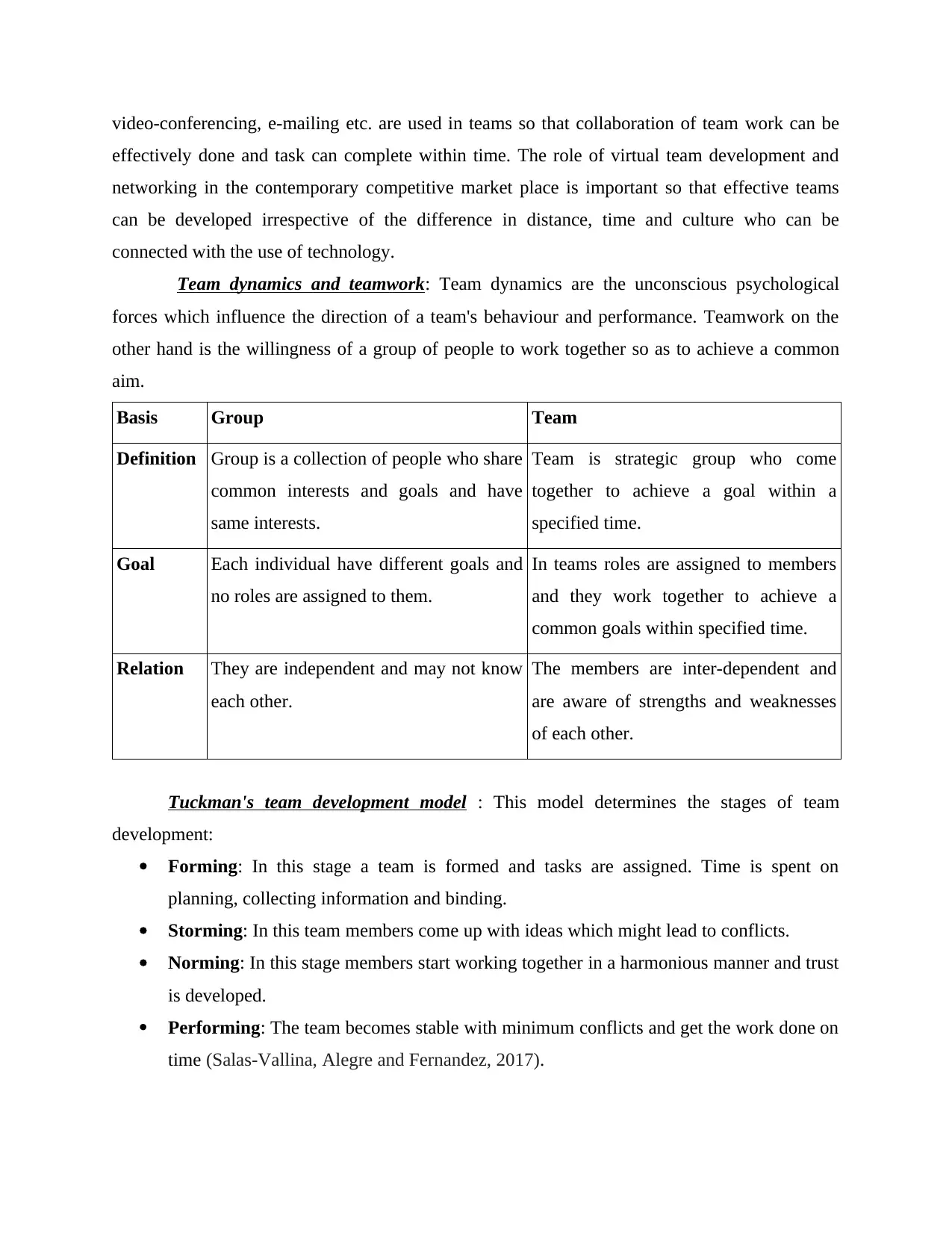
video-conferencing, e-mailing etc. are used in teams so that collaboration of team work can be
effectively done and task can complete within time. The role of virtual team development and
networking in the contemporary competitive market place is important so that effective teams
can be developed irrespective of the difference in distance, time and culture who can be
connected with the use of technology.
Team dynamics and teamwork: Team dynamics are the unconscious psychological
forces which influence the direction of a team's behaviour and performance. Teamwork on the
other hand is the willingness of a group of people to work together so as to achieve a common
aim.
Basis Group Team
Definition Group is a collection of people who share
common interests and goals and have
same interests.
Team is strategic group who come
together to achieve a goal within a
specified time.
Goal Each individual have different goals and
no roles are assigned to them.
In teams roles are assigned to members
and they work together to achieve a
common goals within specified time.
Relation They are independent and may not know
each other.
The members are inter-dependent and
are aware of strengths and weaknesses
of each other.
Tuckman's team development model : This model determines the stages of team
development:
Forming: In this stage a team is formed and tasks are assigned. Time is spent on
planning, collecting information and binding.
Storming: In this team members come up with ideas which might lead to conflicts.
Norming: In this stage members start working together in a harmonious manner and trust
is developed.
Performing: The team becomes stable with minimum conflicts and get the work done on
time (Salas-Vallina, Alegre and Fernandez, 2017).
effectively done and task can complete within time. The role of virtual team development and
networking in the contemporary competitive market place is important so that effective teams
can be developed irrespective of the difference in distance, time and culture who can be
connected with the use of technology.
Team dynamics and teamwork: Team dynamics are the unconscious psychological
forces which influence the direction of a team's behaviour and performance. Teamwork on the
other hand is the willingness of a group of people to work together so as to achieve a common
aim.
Basis Group Team
Definition Group is a collection of people who share
common interests and goals and have
same interests.
Team is strategic group who come
together to achieve a goal within a
specified time.
Goal Each individual have different goals and
no roles are assigned to them.
In teams roles are assigned to members
and they work together to achieve a
common goals within specified time.
Relation They are independent and may not know
each other.
The members are inter-dependent and
are aware of strengths and weaknesses
of each other.
Tuckman's team development model : This model determines the stages of team
development:
Forming: In this stage a team is formed and tasks are assigned. Time is spent on
planning, collecting information and binding.
Storming: In this team members come up with ideas which might lead to conflicts.
Norming: In this stage members start working together in a harmonious manner and trust
is developed.
Performing: The team becomes stable with minimum conflicts and get the work done on
time (Salas-Vallina, Alegre and Fernandez, 2017).
Paraphrase This Document
Need a fresh take? Get an instant paraphrase of this document with our AI Paraphraser
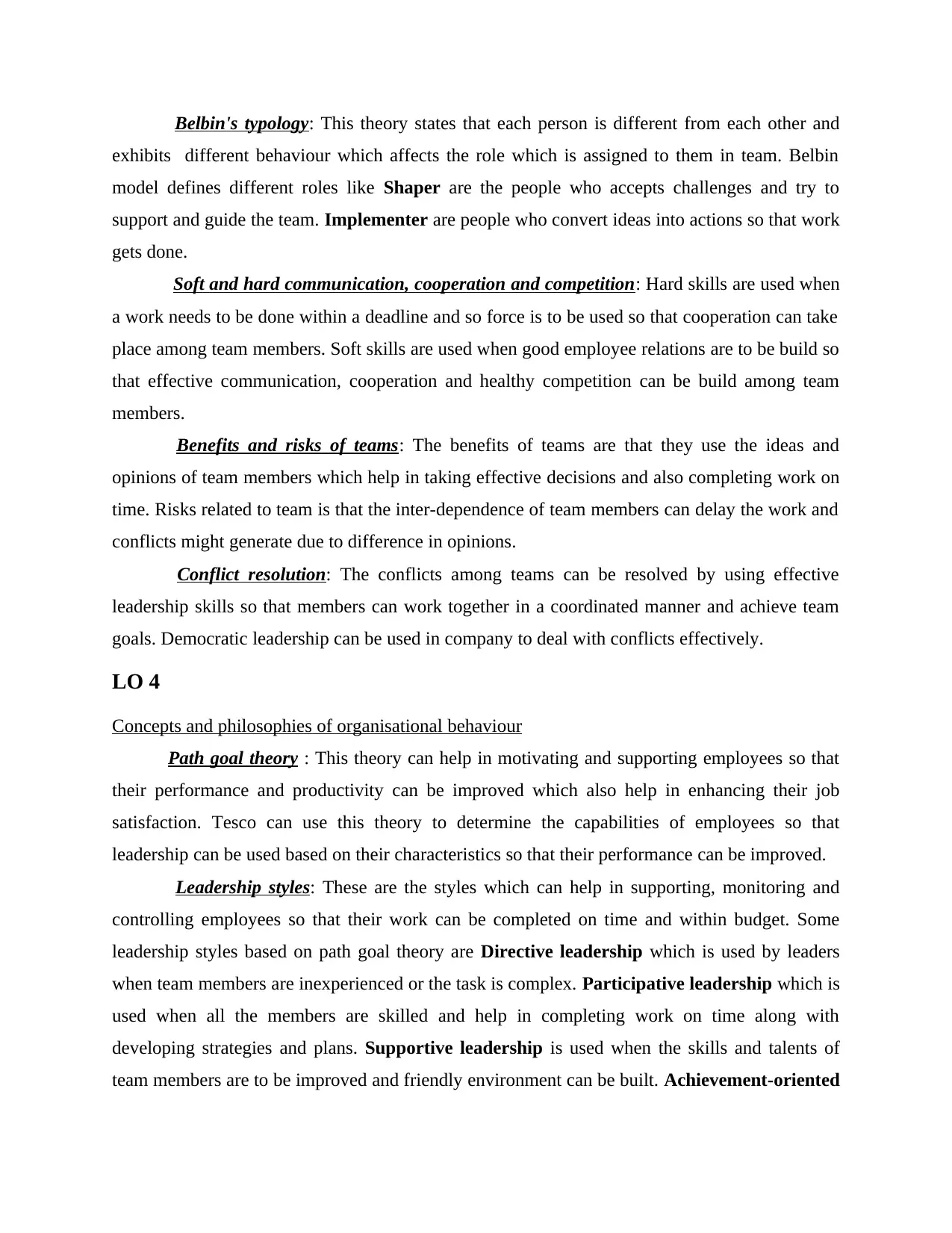
Belbin's typology: This theory states that each person is different from each other and
exhibits different behaviour which affects the role which is assigned to them in team. Belbin
model defines different roles like Shaper are the people who accepts challenges and try to
support and guide the team. Implementer are people who convert ideas into actions so that work
gets done.
Soft and hard communication, cooperation and competition: Hard skills are used when
a work needs to be done within a deadline and so force is to be used so that cooperation can take
place among team members. Soft skills are used when good employee relations are to be build so
that effective communication, cooperation and healthy competition can be build among team
members.
Benefits and risks of teams: The benefits of teams are that they use the ideas and
opinions of team members which help in taking effective decisions and also completing work on
time. Risks related to team is that the inter-dependence of team members can delay the work and
conflicts might generate due to difference in opinions.
Conflict resolution: The conflicts among teams can be resolved by using effective
leadership skills so that members can work together in a coordinated manner and achieve team
goals. Democratic leadership can be used in company to deal with conflicts effectively.
LO 4
Concepts and philosophies of organisational behaviour
Path goal theory : This theory can help in motivating and supporting employees so that
their performance and productivity can be improved which also help in enhancing their job
satisfaction. Tesco can use this theory to determine the capabilities of employees so that
leadership can be used based on their characteristics so that their performance can be improved.
Leadership styles: These are the styles which can help in supporting, monitoring and
controlling employees so that their work can be completed on time and within budget. Some
leadership styles based on path goal theory are Directive leadership which is used by leaders
when team members are inexperienced or the task is complex. Participative leadership which is
used when all the members are skilled and help in completing work on time along with
developing strategies and plans. Supportive leadership is used when the skills and talents of
team members are to be improved and friendly environment can be built. Achievement-oriented
exhibits different behaviour which affects the role which is assigned to them in team. Belbin
model defines different roles like Shaper are the people who accepts challenges and try to
support and guide the team. Implementer are people who convert ideas into actions so that work
gets done.
Soft and hard communication, cooperation and competition: Hard skills are used when
a work needs to be done within a deadline and so force is to be used so that cooperation can take
place among team members. Soft skills are used when good employee relations are to be build so
that effective communication, cooperation and healthy competition can be build among team
members.
Benefits and risks of teams: The benefits of teams are that they use the ideas and
opinions of team members which help in taking effective decisions and also completing work on
time. Risks related to team is that the inter-dependence of team members can delay the work and
conflicts might generate due to difference in opinions.
Conflict resolution: The conflicts among teams can be resolved by using effective
leadership skills so that members can work together in a coordinated manner and achieve team
goals. Democratic leadership can be used in company to deal with conflicts effectively.
LO 4
Concepts and philosophies of organisational behaviour
Path goal theory : This theory can help in motivating and supporting employees so that
their performance and productivity can be improved which also help in enhancing their job
satisfaction. Tesco can use this theory to determine the capabilities of employees so that
leadership can be used based on their characteristics so that their performance can be improved.
Leadership styles: These are the styles which can help in supporting, monitoring and
controlling employees so that their work can be completed on time and within budget. Some
leadership styles based on path goal theory are Directive leadership which is used by leaders
when team members are inexperienced or the task is complex. Participative leadership which is
used when all the members are skilled and help in completing work on time along with
developing strategies and plans. Supportive leadership is used when the skills and talents of
team members are to be improved and friendly environment can be built. Achievement-oriented
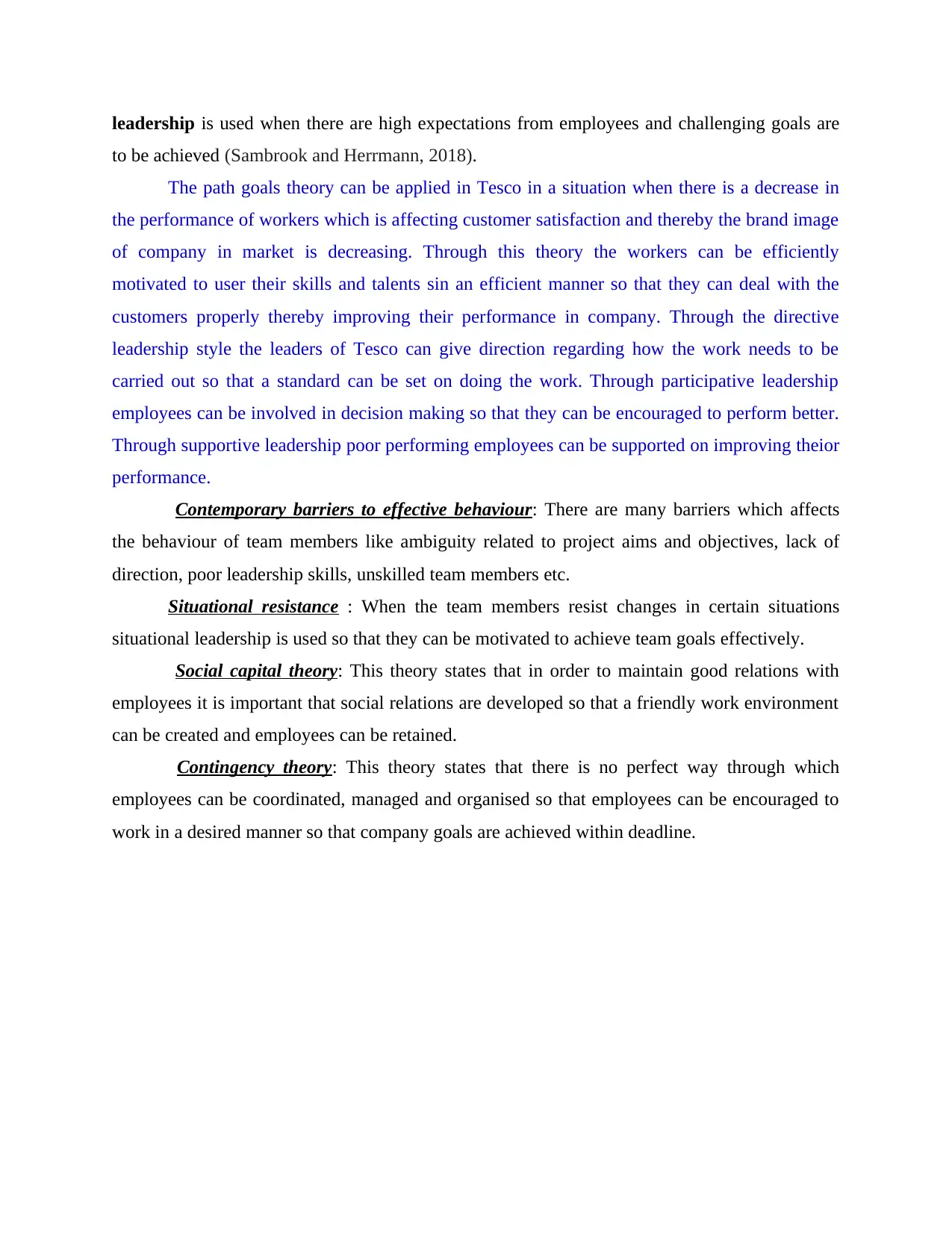
leadership is used when there are high expectations from employees and challenging goals are
to be achieved (Sambrook and Herrmann, 2018).
The path goals theory can be applied in Tesco in a situation when there is a decrease in
the performance of workers which is affecting customer satisfaction and thereby the brand image
of company in market is decreasing. Through this theory the workers can be efficiently
motivated to user their skills and talents sin an efficient manner so that they can deal with the
customers properly thereby improving their performance in company. Through the directive
leadership style the leaders of Tesco can give direction regarding how the work needs to be
carried out so that a standard can be set on doing the work. Through participative leadership
employees can be involved in decision making so that they can be encouraged to perform better.
Through supportive leadership poor performing employees can be supported on improving theior
performance.
Contemporary barriers to effective behaviour: There are many barriers which affects
the behaviour of team members like ambiguity related to project aims and objectives, lack of
direction, poor leadership skills, unskilled team members etc.
Situational resistance : When the team members resist changes in certain situations
situational leadership is used so that they can be motivated to achieve team goals effectively.
Social capital theory: This theory states that in order to maintain good relations with
employees it is important that social relations are developed so that a friendly work environment
can be created and employees can be retained.
Contingency theory: This theory states that there is no perfect way through which
employees can be coordinated, managed and organised so that employees can be encouraged to
work in a desired manner so that company goals are achieved within deadline.
to be achieved (Sambrook and Herrmann, 2018).
The path goals theory can be applied in Tesco in a situation when there is a decrease in
the performance of workers which is affecting customer satisfaction and thereby the brand image
of company in market is decreasing. Through this theory the workers can be efficiently
motivated to user their skills and talents sin an efficient manner so that they can deal with the
customers properly thereby improving their performance in company. Through the directive
leadership style the leaders of Tesco can give direction regarding how the work needs to be
carried out so that a standard can be set on doing the work. Through participative leadership
employees can be involved in decision making so that they can be encouraged to perform better.
Through supportive leadership poor performing employees can be supported on improving theior
performance.
Contemporary barriers to effective behaviour: There are many barriers which affects
the behaviour of team members like ambiguity related to project aims and objectives, lack of
direction, poor leadership skills, unskilled team members etc.
Situational resistance : When the team members resist changes in certain situations
situational leadership is used so that they can be motivated to achieve team goals effectively.
Social capital theory: This theory states that in order to maintain good relations with
employees it is important that social relations are developed so that a friendly work environment
can be created and employees can be retained.
Contingency theory: This theory states that there is no perfect way through which
employees can be coordinated, managed and organised so that employees can be encouraged to
work in a desired manner so that company goals are achieved within deadline.
⊘ This is a preview!⊘
Do you want full access?
Subscribe today to unlock all pages.

Trusted by 1+ million students worldwide
1 out of 14
Related Documents
Your All-in-One AI-Powered Toolkit for Academic Success.
+13062052269
info@desklib.com
Available 24*7 on WhatsApp / Email
![[object Object]](/_next/static/media/star-bottom.7253800d.svg)
Unlock your academic potential
Copyright © 2020–2025 A2Z Services. All Rights Reserved. Developed and managed by ZUCOL.





